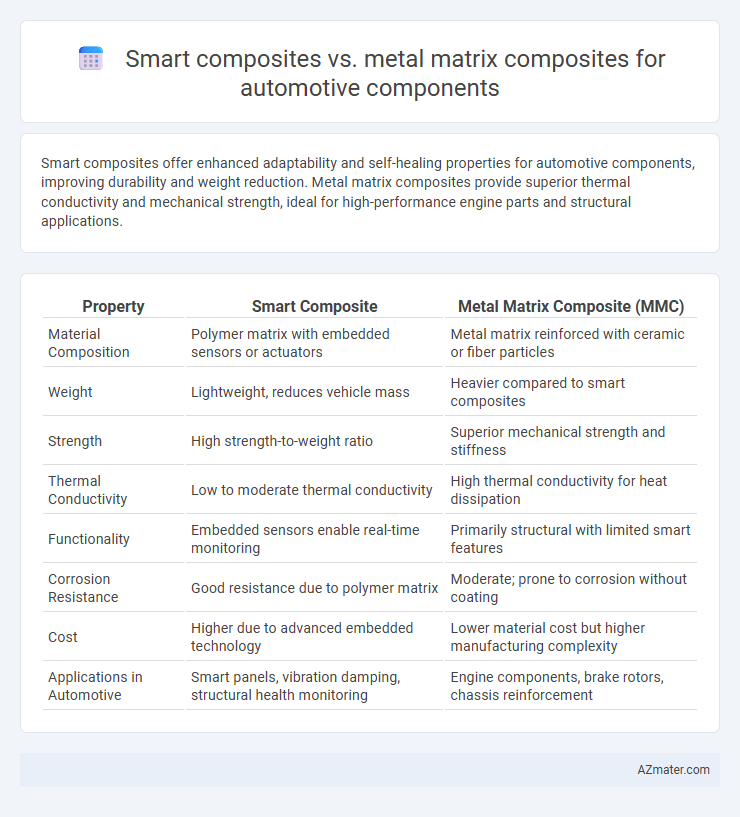Smart composites offer enhanced adaptability and self-healing properties for automotive components, improving durability and weight reduction. Metal matrix composites provide superior thermal conductivity and mechanical strength, ideal for high-performance engine parts and structural applications.
Table of Comparison
| Property | Smart Composite | Metal Matrix Composite (MMC) |
|---|---|---|
| Material Composition | Polymer matrix with embedded sensors or actuators | Metal matrix reinforced with ceramic or fiber particles |
| Weight | Lightweight, reduces vehicle mass | Heavier compared to smart composites |
| Strength | High strength-to-weight ratio | Superior mechanical strength and stiffness |
| Thermal Conductivity | Low to moderate thermal conductivity | High thermal conductivity for heat dissipation |
| Functionality | Embedded sensors enable real-time monitoring | Primarily structural with limited smart features |
| Corrosion Resistance | Good resistance due to polymer matrix | Moderate; prone to corrosion without coating |
| Cost | Higher due to advanced embedded technology | Lower material cost but higher manufacturing complexity |
| Applications in Automotive | Smart panels, vibration damping, structural health monitoring | Engine components, brake rotors, chassis reinforcement |
Introduction to Automotive Composites
Automotive components increasingly utilize smart composites and metal matrix composites (MMCs) for enhanced performance and lightweight properties. Smart composites integrate sensors and actuators within the material, enabling real-time health monitoring and adaptive response to driving conditions. Metal matrix composites combine metals such as aluminum or magnesium with ceramic reinforcements, delivering superior strength, wear resistance, and thermal stability critical for engine and structural applications.
Overview of Smart Composites
Smart composites in automotive components integrate responsive materials like shape memory alloys or piezoelectric fibers, enhancing adaptability and real-time performance monitoring. These composites offer superior vibration damping, self-healing capabilities, and damage detection compared to traditional Metal Matrix Composites (MMCs). Their ability to respond to environmental stimuli improves vehicle safety and durability while reducing maintenance costs.
Metal Matrix Composites: Key Characteristics
Metal Matrix Composites (MMCs) in automotive components offer high strength-to-weight ratios, excellent thermal conductivity, and superior wear resistance compared to traditional materials. These composites typically incorporate aluminum or magnesium matrices reinforced with ceramic fibers or particles, enhancing mechanical performance under high stress and temperature conditions. MMCs enable improved fuel efficiency and durability in automotive applications by reducing component weight while maintaining structural integrity.
Mechanical Properties Comparison
Smart composites exhibit enhanced mechanical properties such as superior strength-to-weight ratio, improved impact resistance, and better fatigue life compared to traditional metal matrix composites (MMCs) used in automotive components. MMCs provide excellent thermal stability and wear resistance but tend to be heavier and less flexible under cyclic loading conditions. Optimizing the composite design with smart materials allows for tailored stiffness and damping characteristics, significantly improving performance and durability in automotive applications.
Weight Reduction and Fuel Efficiency
Smart composites offer enhanced weight reduction compared to traditional metal matrix composites by integrating sensors and responsive materials that adapt to stress, leading to optimized structural performance. Metal matrix composites provide substantial strength-to-weight ratios, but smart composites further decrease overall vehicle weight, directly improving fuel efficiency. Incorporating smart composite materials in automotive components results in lighter vehicles with better energy consumption profiles, achieving superior fuel economy and reduced emissions.
Manufacturing Processes and Scalability
Smart composites for automotive components primarily leverage additive manufacturing and automated layering techniques, enabling precise control over material properties and complex geometries, which supports rapid prototyping and low-volume production scalability. Metal matrix composites (MMC), produced through powder metallurgy, infiltration, and casting methods, offer high strength-to-weight ratios but face challenges in manufacturing complexity and cost-effectiveness during mass production. Scalability in MMC manufacturing is often limited by energy-intensive processes and tooling requirements, while smart composites benefit from flexible, digitally controlled fabrication systems that facilitate easier adaptation to varying production scales.
Cost Implications in Automotive Applications
Smart composites offer cost advantages over metal matrix composites (MMCs) in automotive applications due to lower raw material and manufacturing expenses, enabling easier scalability for mass production. MMCs involve higher initial investment because of expensive metal powders, complex processing techniques like stir casting or powder metallurgy, and the need for specialized equipment, which raises overall production costs. However, smart composites often deliver comparable performance with reduced weight, contributing to long-term savings in fuel efficiency and maintenance, making them a cost-effective alternative for automotive components.
Performance under Extreme Conditions
Smart composites in automotive components exhibit adaptive properties such as self-sensing and self-healing, enhancing durability and performance under extreme temperatures and mechanical stress. Metal matrix composites (MMCs) provide superior thermal conductivity, high strength-to-weight ratio, and excellent wear resistance, making them ideal for high-load applications and harsh environments. Comparing the two, MMCs generally offer better structural integrity under severe mechanical and thermal cycling, while smart composites excel in monitoring and mitigating damage in real-time.
Sustainability and Recyclability
Smart composites in automotive components enhance sustainability through lightweight designs and adaptive properties, leading to reduced fuel consumption and lower emissions. Metal matrix composites offer high strength and thermal resistance but present challenges in recyclability due to complex material separation processes. Prioritizing smart composites can improve the automotive industry's circular economy by facilitating easier recycling and minimizing environmental impact.
Future Trends in Automotive Composite Materials
Smart composites offer adaptive properties such as self-sensing and self-healing, making them ideal for next-generation automotive components that demand enhanced durability and real-time performance monitoring. Metal matrix composites provide superior thermal conductivity and mechanical strength, crucial for high-load engine parts and lightweight structural applications. Future trends in automotive composite materials emphasize integrating smart functionalities with metal matrix composites to achieve optimized weight reduction, improved fuel efficiency, and advanced safety features.

Infographic: Smart composite vs Metal matrix composite for Automotive component
 azmater.com
azmater.com